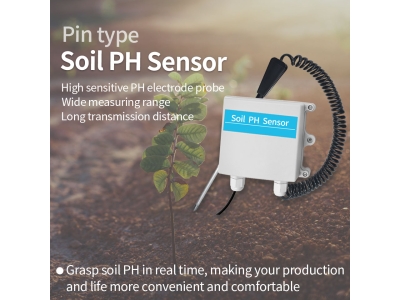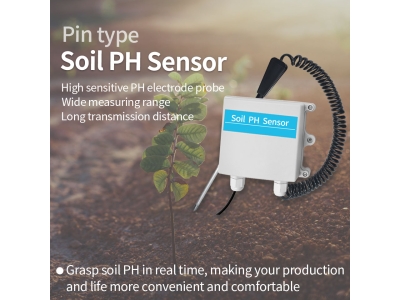In an era where sustainable practices are becoming increasingly important, the role of technology in modern agriculture cannot be ignored. Conservation farming, with its focus on minimizing environmental impact while maximizing productivity, has gained traction worldwide. One of the key technologies driving this movement is soil sensors. These innovative devices provide valuable insights into soil health, enabling farmers to make informed decisions and adopt more sustainable practices. In this article, we delve into the world of soil sensors and explore their role in conservation farming.

The Importance of Soil Health:
Soil health forms the foundation of a successful farming operation. It encompasses a range of factors, including nutrient levels, organic matter content, pH balance, moisture retention, and microbial activity. Healthy soil not only supports crop growth but also provides various ecosystem services such as water filtration, carbon sequestration, and biodiversity preservation. By monitoring and improving soil health, farmers can enhance sustainability, productivity, and resilience in their farms.
Understanding Soil Sensors:
Soil sensors, also known as soil probes or soil monitoring systems, are advanced technological tools used to measure and analyze soil parameters. These sensors are typically inserted into the ground at various depths to collect real-time data on key soil characteristics. They can measure parameters such as soil moisture, temperature, electrical conductivity, pH levels, nutrient availability, and compaction. The collected data is then transmitted to a central system or accessible through a mobile app, allowing farmers to monitor soil conditions remotely.
Real-Time Monitoring for Precision Agriculture:
One of the primary advantages of soil sensors is their ability to provide real-time data on soil conditions. Traditional soil testing methods often involve time-consuming laboratory analysis and do not capture the dynamic nature of soil. With soil sensors, farmers can access up-to-date information on crucial parameters, enabling them to make timely decisions about irrigation, fertilization, and pest control. Real-time monitoring facilitates precision agriculture, where inputs are precisely targeted, reducing waste and environmental impact.
Water Management and Irrigation Efficiency:
Water scarcity is a significant global concern, making efficient water management imperative in agriculture. Soil sensors play a vital role in optimizing irrigation practices. By continuously monitoring soil moisture levels, farmers can determine when and how much water to apply. This precision ensures that crops receive the right amount of water at the right time, minimizing water wastage and reducing the risk of overwatering or underwatering. Improved irrigation efficiency not only conserves water but also enhances crop yield and quality.
Nutrient Management and Fertilizer Optimization:
Proper nutrient management is essential for sustainable farming. Soil sensors provide valuable insights into nutrient levels and availability in the soil. By analyzing real-time data, farmers can make informed decisions about fertilizer application, ensuring that nutrients are supplied according to the specific needs of the crops. This optimization reduces the risk of nutrient runoff, which can lead to water pollution, and minimizes unnecessary fertilizer use, ultimately saving costs and preserving water quality.
Soil pH and Acidity Management:
Soil pH plays a critical role in nutrient availability and microbial activity. Soil sensors can measure pH levels accurately, allowing farmers to identify acidic or alkaline conditions that may hinder crop growth. With this information, farmers can take corrective measures by applying soil amendments to balance pH levels and create optimal growing conditions. By maintaining appropriate soil pH, nutrient uptake by plants is maximized, leading to improved crop health and productivity.
Detecting Soil Compaction:
Soil compaction, often caused by heavy machinery and excessive traffic, can greatly impact crop growth. Soil sensors can detect and monitor soil compaction levels, providing farmers with insights into areas that require remedial action. By identifying compacted areas, farmers can implement strategies such as deep tillage, cover cropping, or controlled traffic systems to alleviate compaction. This helps improve soil structure, root development, and overall crop performance.
Disease and Pest Management:
Soil sensors can also contribute to disease and pest management strategies. By monitoring soil conditions such as moisture, temperature, and microbial activity, farmers can identify favorable conditions for disease development or pest infestations. Early detection allows for timely interventions, such as adjusting irrigation practices or implementing targeted pest control measures. By preventing or minimizing the impact of diseases and pests, farmers can reduce yield losses and decrease reliance on chemical inputs.
Data Analysis and Decision Support Systems:
The vast amount of data collected by soil sensors can be overwhelming without proper analysis and interpretation. Fortunately, advancements in data analytics and decision support systems have made it easier to derive meaningful insights from soil sensor data. Machine learning algorithms can be applied to identify patterns, predict trends, and provide actionable recommendations. These tools assist farmers in making informed decisions about optimal planting dates, crop rotations, input optimization, and resource allocation, leading to improved productivity and environmental stewardship.
Challenges and Future Developments:
While soil sensors offer tremendous potential, some challenges need to be addressed. Calibration and accuracy of sensors, data management and integration, and affordability remain areas of focus for researchers and technology developers. Furthermore, providing comprehensive training and technical support to farmers is crucial for successful adoption and effective utilization of soil sensor technology. As technology advances and costs decrease, soil sensors are expected to become more accessible to farmers of all scales.
Conclusion:
Soil sensors are revolutionizing agriculture by providing real-time data on crucial soil parameters. With their ability to monitor soil moisture, fertility, pH levels, and compaction, these sensors enable farmers to make informed decisions and adopt sustainable practices. By optimizing water and nutrient management, managing soil pH, and improving disease and pest control, farmers can enhance productivity while minimizing environmental impact. As technology continues to advance, soil sensors will play an increasingly vital role in the transition towards more sustainable and efficient farming practices, ensuring a greener and more prosperous future for agriculture.






